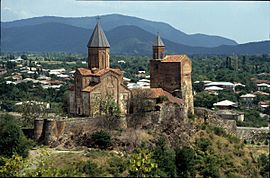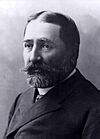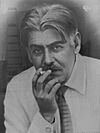Qvareli Municipality facts for kids
Quick facts for kids
Kvareli Municipality
ყვარლის მუნიციპალიტეტი
|
|||
|---|---|---|---|
|
Municipality
|
|||

Gremi
|
|||
|
|||

Qvareli Municipality
|
|||
| Country | Georgia | ||
| Mkhare | Kakheti | ||
| capital city | Kvareli | ||
| Area | |||
| • Total | 1,000.8 km2 (386.4 sq mi) | ||
| Population
(2014)
|
|||
| • Total | 29,827 | ||
| • Density | 29,80/km2 (7,700/sq mi) | ||
| Population by ethnicity | |||
| • Georgians | 93.84% | ||
| • Avars | 3.26% | ||
| • Ossetians | 1.21% | ||
| • Udis | 0.55% | ||
| • Armenians | 0.47% | ||
| Time zone | UTC+4 (Georgian Standard Time) | ||
| Website | http://kvareli.gov.ge/ | ||
Kvareli Municipality (Georgian: ყვარლის მუნიციპალიტეტი) is a part of eastern Georgia. It is located in the northeastern area of the Kakheti region. Before 1917, this area was part of Telavi Mazra. In 1930, it became a separate district. Today, it is a municipality. The main city, Kvareli, became a city in 1964. It is located where the Bursa and Duruji rivers meet. The total area of the municipality is about 1000.8 square kilometers.
Contents
History of Kvareli Municipality
Ancient settlements have been found in the Kvareli area. Archaeologists have found items from the Bronze Age in places like Shielda and Enisli. Old Gavazi (now Akhalsofeli), Balghojiani, and Gremi also have old household and war items.
Nekresi: An Ancient Religious Center
The Nekresi area is home to very old religious buildings. King Pharnajom of Iberia founded Nekresi in the 2nd–1st century BC. In the 4th century, King Thrdat built a church there. Later, in the 6th century, Abibos of Nekresi, one of the Assyrian fathers, settled there. This led to the creation of the Nekresi episcopal diocese. This diocese was very important. It even included parts of Dagestan.
The Nekresi monastery complex has several old Georgian buildings. A small basilica from the 4th century is one of Georgia's oldest churches. A larger basilica was built in the early 7th century. A tower was added in the 16th century to the bishop's palace. You can also find ruins of homes, shops, and small chapels there.
Gremi: The Capital of Kakheti
In the 15th and 16th centuries, the kingdom of Kakheti was very strong. Its capital city was Gremi. The unique Gremi fortress, with its Church of the Archangel, shows how important it was. Gremi was a major trade and economic center in old Georgia. Important trade routes, like the "Silk Road", passed through Gremi. This road connected China with the Mediterranean and Black Sea countries.
Not much information remains about daily life in Gremi. However, the buildings and archaeological finds show how powerful it was. In 1614–1616, Shah Abbas I of Iran attacked Gremi. The city was destroyed and became ruins. Gremi remained the capital for a short time but never regained its old glory. In 1667, King Archil moved the capital to Telavi. Telavi was safer from attacks by Dagestan lords.
Areshi and Kvareli's Name
Areshi, or Arishi, was an old village in Kvareli municipality. Today, the village of Mtisdziri is in its place. Areshi was a key location in ancient Hereti. It was on a trade route connecting Kartli and Kakheti to other regions. A sheep road, still used today, also passed through Areshi. People from Areshi helped unite Georgia.
There are many stories about how Kvareli got its name. One legend says a king liked the area while hunting and ordered a village to be built there. Another story says that in the 4th century, Pshavians from a village called Kvara settled here. These settlers were called Kvarlelis, and the settlement took this name. Over time, it changed to Qvareli.
Towns and Villages
Kvareli Municipality has one town and 21 villages. The main town is Kvareli.
Here are some of the administrative units and their villages:
- Kvareli administrative unit – Kvareli
- Mtisdziri administrative unit – Mtisdziri village
- Balghojiani administrative unit – Balghojiani village
- Akhalsopeli administrative unit – villages: Akhalsopeli, Tkhilistskaro, Shorokhi, Satskhene, Tivi
- Chikaani administrative unit – villages: Chikaani, Zinobiani, Chantliskure
- Kuchatni administrative unit – villages: Kuchatani, Sanavardo, Tsitskanaantseri
- Gavazi administrative unit – Gavazi village
- Shilda administrative unit – village Shilda
- Eniseli administrative unit – Eniseli village
- Sabue administrative unit – villages: Sabue, Almati
- Gremi administrative unit – villages: Gremi, Shakriani, Grdzelichala.
Population and Ethnic Groups
According to the 2014 census, Kvareli Municipality has 29,827 people. Most residents are Georgians (93.84%). It is also home to almost all of Georgia's Avar community. About 973 Avars live here, making up 3.26% of the population. Three villages – Shorokhi, Chantliskure, and Tivi – have an Avar majority.
The village of Zinobiani is special because it is home to most of Georgia's Udi community. Out of 174 Udis in Georgia, 164 live in Zinobiani. This village is almost equally split between Udis and Georgians.
Geography and Weather
Kvareli Municipality shares borders with three other municipalities: Telavi Municipality, Gurjaani Municipality, and Lagodekhi Municipality. It also borders the Autonomous Republic of Dagestan.
The area has a moderately humid subtropical climate.
- In lower areas (up to 1000–1200 meters), winters are moderately cold and summers are warm. The average yearly temperature is 8–9 °C.
- At higher elevations (1700–1800 meters), winters are cold and summers are long and cool. The average yearly temperature is 5–6 °C.
- Above 1800 meters, the average yearly temperature drops to 3–4 °C.
The amount of rain changes depending on the area, from 795 mm to 938 mm per year. Most rain falls in May, and the least in January.
Education and Learning
Kvareli Municipality has many places for learning.
- There are 21 public schools and one private school.
- There are 21 kindergartens, one nursery, and three alternative kindergartens.
- About 3350 students attend schools.
- Around 1100 children are enrolled in kindergartens.
- The municipality also has seven libraries (six in rural areas, one in the city).
- There is one student youth center and seven music schools.
Culture and Arts
Theatre
The People's Theater in Kvareli is named after Kote Marjanishvili. He was a famous Georgian theatre founder. Amateur actors mostly perform here.
Festivals
Kvareli Municipality celebrates important traditional events.
| Event | Date | Description |
|---|---|---|
| "Iliaoba" | 8 November | "Iliaoba" is a special public holiday. It has been celebrated almost every year on November 8 since 1937. |
Sports
The sports school in Kvareli has nine different departments.
- These include volleyball, handball, basketball, freestyle wrestling, judo, Georgian wrestling, boxing, karate, and chess.
- About 600 student-athletes take part in these sports.
- World champion Zurab Iakobishvili trained at the Kvareli sports school.
Economy and Work
Agriculture is very important in Kvareli Municipality.
- Viticulture (growing grapes) is the main type of farming. It brings in 80% of all farming income.
- About 35,945 hectares of land are used for farming.
- Animal husbandry (raising animals) and poultry farming (raising chickens and other birds) are also developed.
- Winemaking is growing fast, with many new wineries opening.
- The world-famous "Kindzmarauli" grape area is located here.
Historical Places and Sights
Many historical sites can be found in Kvareli Municipality.
- Gremi village is at 480 meters above sea level. People likely lived here since the Late Bronze Age. Gremi was a major trade and cultural center during the feudal era. In 1466, it became the capital of the Kingdom of Kakheti.
- The Archangel Church of Gremi is an important building. King Levan of Kakheti built it in 1565.
- The ruins of the Church of the Virgin in Shilda are also important. Locals call it "All Saints" of Bartskhana.
- The old Church of the Virgin of Gavazi (from the 6th century) still stands.
- The Cathedral of the Resurrection (1574–1605) is in Eniseli.
- The historical city of Nekresi was founded by King Farnajom in the 2nd–1st centuries BC.
Other interesting old buildings include:
- The dome church "Kvaratskhoveli" in Chikaani village (15th-17th centuries).
- Ruins of the Temple of the Sun from 3000 years ago.
Museums and Cultural Spots
- Ilia Chavchavadze Museum
- Kote Marjanishvili Museum
- Money Museum
- Qvareli Public Theater (named after Kote Marjanishvili)
- Gremi Museum
- Qvareli Fortress
Famous People from Kvareli
| Photo | Name and Surname | Years | Description |
|---|---|---|---|
 |
Ilia Chavchavadze | 1837–1907 | A famous Georgian public figure, writer, and politician. |
 |
Kote Marjanishvili | 1872–1933 | A well-known Georgian director and artist. |
 |
Mako Safarova-Abashidze | 1860–1940 | A Georgian actress. |
 |
Vakhtang Tabliashvili | 1914–2002 | A Georgian director. |
Sister Municipalities
Kvareli Municipality has special friendly ties with other municipalities:
See also
 In Spanish: Municipio de Kvareli para niños
In Spanish: Municipio de Kvareli para niños




